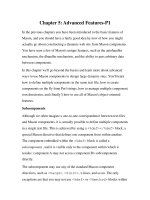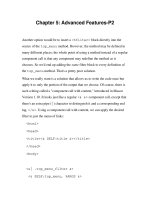Chapter 5 v7 01 accessible
Bạn đang xem bản rút gọn của tài liệu. Xem và tải ngay bản đầy đủ của tài liệu tại đây (3.78 MB, 90 trang )
Computer Networking: A Top Down
Approach
Seventh Edition
Chapter 5
The Network Layer:
Control Plane
Slides in this presentation contain hyperlinks.
JAWS users should be able to get a list of links
by using INSERT+F7
Copyright © 2017, 2013, 2010 Pearson Education, Inc. All Rights Reserved
Chapter 5: Network Layer Control Plane
chapter goals: understand principles behind network
control plane
• traditional routing algorithms
• SDN controlllers
• Internet Control Message Protocol
• network management
and their instantiation, implementation in the Internet:
• OSPF, BGP, OpenFlow, ODL and ONOS controllers, ICM
P, SNMP
Copyright © 2017, 2013, 2010 Pearson Education, Inc. All Rights Reserved
Learning Objectives (1 of 9)
5.1 introduction
5.2 routing protocols
‒ link state
‒ distance vector
5.3 intra-AS routing in the Internet: OSPF
5.4 routing among the ISPs: BGP
5.5 The SDN control plane
5.6 ICMP: The Internet Control Message Protocol
5.7 Network management and SNMP
Copyright © 2017, 2013, 2010 Pearson Education, Inc. All Rights Reserved
Network-Layer Functions
Recall: two network-layer
functions:
• forwarding: move packets
data plane
from router’s input to
appropriate router output
• routing: determine route
taken by packets from
source to destination
control plane
Two approaches to structuring network control
plane:
• per-router control (traditional)
• logically centralized control (software defined
networking) Copyright © 2017, 2013, 2010 Pearson Education, Inc. All Rights Reserved
Per-Router Control Plane
Individual routing algorithm components in each
and every router interact with each other in
control plane to compute forwarding tables
Copyright © 2017, 2013, 2010 Pearson Education, Inc. All Rights Reserved
Logically Centralized Control Plane
A distinct (typically remote) controller interacts with
local control agents (CAs) in routers to compute
forwarding tables
Copyright © 2017, 2013, 2010 Pearson Education, Inc. All Rights Reserved
Learning Objectives (2 of 9)
5.1 introduction
5.2 routing protocols
– link state
– distance vector
5.3 intra-AS routing in the Internet: OSPF
5.4 routing among the ISPs: BGP
5.5 The SDN control plane
5.6 ICMP: The Internet Control Message Protocol
5.7 Network management and SNMP
Copyright © 2017, 2013, 2010 Pearson Education, Inc. All Rights Reserved
Routing Protocols
Routing protocol goal: determine “good” paths
(equivalently, routes), from sending hosts to
receiving host, through network of routers
• path: sequence of routers packets will traverse in
going from given initial source host to given final
destination host
• “good”: least “cost”, “fastest”, “least congested”
• routing: a “top-10” networking challenge!
Copyright © 2017, 2013, 2010 Pearson Education, Inc. All Rights Reserved
Graph Abstraction of the Network
graph: G = (N, E)
N = set of routers = { u, v, w, x, y, z }
E = set of links ={ (u,v), (u,x), (v,x), (v,w), (x,w), (x,y),
(w,y), (w,z), (y,z) }
aside: graph abstraction is useful in other network
contexts, e.g., P2P, where N is set of peers and E is set of
TCP connections
Copyright © 2017, 2013, 2010 Pearson Education, Inc. All Rights Reserved
Graph Abstraction: Costs
c x,x = cost of link x,x e.g., c w,z = 5
cost could always be 1, or
inversely related to
bandwidth, or inversely
related to congestion
cost of path (x1, x 2, x 3 ,…,x p ) = c(x1,x 2 ) + c(x 2,x 3 ) + … + c(x p-1, x p )
key question: what is the least-cost path between u and z?
routing algorithm: algorithm that finds that least cost path
Copyright © 2017, 2013, 2010 Pearson Education, Inc. All Rights Reserved
Routing Algorithm Classification
Q: global or decentralized
information?
global:
• all routers have complete topology,
link cost info
• “link state” algorithms
decentralized:
• router knows physically-connected
neighbors, link costs to neighbors
• iterative process of computation,
exchange of info with neighbors
• “distance vector” algorithms
Q: static or dynamic?
static:
• routes change slowly
over time
dynamic:
• routes change more
quickly
– periodic update
– in response to link
cost changes
Copyright © 2017, 2013, 2010 Pearson Education, Inc. All Rights Reserved
Learning Objectives (3 of 9)
5.1 introduction
5.2 routing protocols
– link state
– distance vector
5.3 intra-AS routing in the Internet: OSPF
5.4 routing among the ISPs: BGP
5.5 The SDN control plane
5.6 ICMP: The Internet Control Message Protocol
5.7 Network management and SNMP
Copyright © 2017, 2013, 2010 Pearson Education, Inc. All Rights Reserved
A Link-State Routing Algorithm
Dijkstra’s algorithm
notation:
• net topology, link costs known to all
nodes
– accomplished via “link state
broadcast”
– all nodes have same info
• c(x,y): link cost from
node
x to y; if not direct
neighbors
• computes least cost paths from one
node (‘source”) to all other nodes
– gives forwarding table for that
node
• iterative: after k iterations, know least
cost path to k dest.’s
• D(v): current value of cost
of path from source to
dest. v
• p(v): predecessor node
along path from source to
v
• N': set of nodes whose
least cost path definitively
known
Copyright © 2017, 2013, 2010 Pearson Education, Inc. All Rights Reserved
Dijsktra’s Algorithm
Copyright © 2017, 2013, 2010 Pearson Education, Inc. All Rights Reserved
Dijkstra’s Algorithm: Example (1 of 2)
notes:
• construct shortest path tree by
tracing predecessor nodes
ã ties can exist (can be broken
arbitrarily)
Copyright â 2017, 2013, 2010 Pearson Education, Inc. All Rights Reserved
Dijkstra’s Algorithm: Another Example
* Check out the online interactive exercises for more examples:
/>Copyright © 2017, 2013, 2010 Pearson Education, Inc. All Rights Reserved
Dijkstra’s Algorithm: Example (2 of 2)
• resulting forwarding table
in u:
resulting shortest-path tree
from u:
destination
Link
V
(u,v)
X
(u,x)
Y
(u,x)
W
(u,x)
Z
(u,x)
Copyright © 2017, 2013, 2010 Pearson Education, Inc. All Rights Reserved
Dijkstra’s Algorithm, Discussion (1 of 2)
algorithm complexity: n nodes
• each iteration: need to check all nodes, w, not in N
• n n+1 /2 comparisons: O n2
• more efficient implementations possible:
O(nlogn)
oscillations possible:
• e.g., support link cost equals amount of carried
traffic:
Copyright © 2017, 2013, 2010 Pearson Education, Inc. All Rights Reserved
Dijkstra’s Algorithm, Discussion (2 of 2)
Copyright © 2017, 2013, 2010 Pearson Education, Inc. All Rights Reserved
Learning Objectives (4 of 9)
5.1 introduction
5.2 routing protocols
– link state
– distance vector
5.3 intra-AS routing in the Internet: OSPF
5.4 routing among the ISPs: BGP
5.5 The SDN control plane
5.6 ICMP: The Internet Control Message Protocol
5.7 Network management and SNMP
Copyright © 2017, 2013, 2010 Pearson Education, Inc. All Rights Reserved









